View in other NatureServe Network Field Guides
NatureServe
Montana
Utah
Wyoming
Idaho
Wisconsin
British Columbia
South Carolina
Yukon
California
New York
Plains Emerald - Somatochlora ensigera
Native Species
Global Rank:
G4
State Rank:
S4
Agency Status
USFWS:
USFS:
BLM:
External Links
General Description
A conspicuously marked species, easily known by its almost entirely yellow face, the peculiar shape of the anal appendages of the male, and the very short anal appendages of the female, together with a long projecting vulvar lamina (Walker and Corbett, 1975). Length 48-51 mm.; abdomen 35-38; hind wing 33-35. An inland species of medium size and well-defined markings. Orange labrum with black front border and median basal spot. Frons has a broad cap of metallic blue green; its side spots of yellow narrow forward to meet or nearly meet on middle line in front. Occiput shining brown. Thorax scantily hairy. Side stripes of thorax and of abdominal segment 2 bright yellow, bordered by black. Thorax dark reddish brown in front, with yellow carina; it becomes bluish toward crest and between yellow stripes on sides. Wings hyaline, touched with amber yellow at extreme base. Costa ochre yellow; stigma blackish; veins brown. Abdomen brown, much swollen on segment 2; two large antero-lateral spots, in male a smaller postero-lateral spot runs down and half covers genital lobe. Of two usual elongate lateral triangles on segment 3, lower one is much longer. Remainder of abdomen and caudal appendages black. This species nearly like linearis but smaller and more brightly marked with yellow. Caudal appendages of male more slender and more nearly parallel in their apical third. Ovipositor of female longer, straighter, more slender (Needham and Westfall, 1955).
Species Range
Montana Range
Range Descriptions
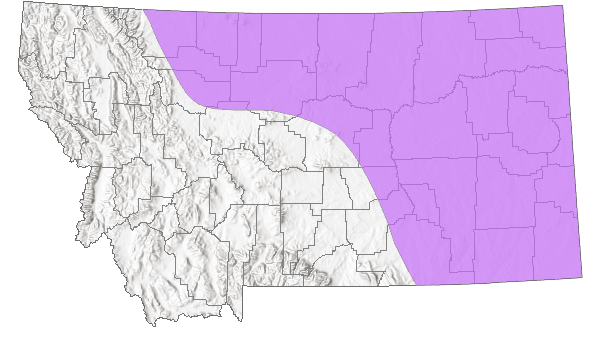
 Native
Native
Range Comments
Montana is the type locality for this species.
Observations in Montana Natural Heritage Program Database
Number of Observations: 36
(Click on the following maps and charts to see full sized version)
Map Help and Descriptions
Relative Density
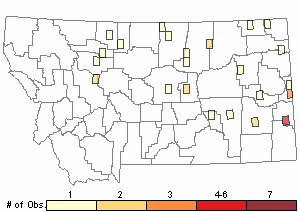
Recency
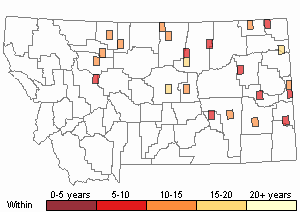
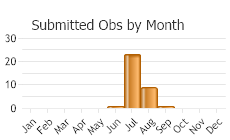
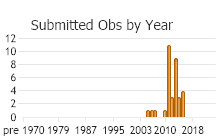
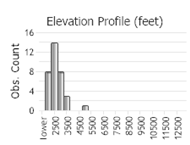 (Observations spanning multiple months or years are excluded from time charts)
(Observations spanning multiple months or years are excluded from time charts)
Habitat
The Plains Emerald prefers habitats of streams, small rivers,and ditches with pools and riffles in open areas (Dunkle 2000, Paulson 2009).
Ecological Systems Associated with this Species
- Details on Creation and Suggested Uses and Limitations
How Associations Were Made
We associated the use and habitat quality (common or occasional) of each of the 82 ecological systems mapped in Montana for
vertebrate animal species that regularly breed, overwinter, or migrate through the state by:
- Using personal observations and reviewing literature that summarize the breeding, overwintering, or migratory habitat requirements of each species (Dobkin 1992, Hart et al. 1998, Hutto and Young 1999, Maxell 2000, Foresman 2012, Adams 2003, and Werner et al. 2004);
- Evaluating structural characteristics and distribution of each ecological system relative to the species' range and habitat requirements;
- Examining the observation records for each species in the state-wide point observation database associated with each ecological system;
- Calculating the percentage of observations associated with each ecological system relative to the percent of Montana covered by each ecological system to get a measure of "observations versus availability of habitat".
Species that breed in Montana were only evaluated for breeding habitat use, species that only overwinter in Montana were only evaluated for overwintering habitat use, and species that only migrate through Montana were only evaluated for migratory habitat use.
In general, species were listed as associated with an ecological system if structural characteristics of used habitat documented in the literature were present in the ecological system or large numbers of point observations were associated with the ecological system.
However, species were not listed as associated with an ecological system if there was no support in the literature for use of structural characteristics in an ecological system,
even if point observations were associated with that system.
Common versus occasional association with an ecological system was assigned based on the degree to which the structural characteristics of an ecological system matched the preferred structural habitat characteristics for each species as represented in scientific literature.
The percentage of observations associated with each ecological system relative to the percent of Montana covered by each ecological system was also used to guide assignment of common versus occasional association.
If you have any questions or comments on species associations with ecological systems, please contact the Montana Natural Heritage Program's Senior Zoologist.
Suggested Uses and Limitations
Species associations with ecological systems should be used to generate potential lists of species that may occupy broader landscapes for the purposes of landscape-level planning.
These potential lists of species should not be used in place of documented occurrences of species (this information can be requested at:
mtnhp.mt.gov/requests) or systematic surveys for species and evaluations of habitat at a local site level by trained biologists.
Users of this information should be aware that the land cover data used to generate species associations is based on imagery from the late 1990s and early 2000s and was only intended to be used at broader landscape scales.
Land cover mapping accuracy is particularly problematic when the systems occur as small patches or where the land cover types have been altered over the past decade.
Thus, particular caution should be used when using the associations in assessments of smaller areas (e.g., evaluations of public land survey sections).
Finally, although a species may be associated with a particular ecological system within its known geographic range, portions of that ecological system may occur outside of the species' known geographic range.
Literature Cited
- Adams, R.A. 2003. Bats of the Rocky Mountain West; natural history, ecology, and conservation. Boulder, CO: University Press of Colorado. 289 p.
- Dobkin, D. S. 1992. Neotropical migrant land birds in the Northern Rockies and Great Plains. USDA Forest Service, Northern Region. Publication No. R1-93-34. Missoula, MT.
- Foresman, K.R. 2012. Mammals of Montana. Second edition. Mountain Press Publishing, Missoula, Montana. 429 pp.
- Hart, M.M., W.A. Williams, P.C. Thornton, K.P. McLaughlin, C.M. Tobalske, B.A. Maxell, D.P. Hendricks, C.R. Peterson, and R.L. Redmond. 1998. Montana atlas of terrestrial vertebrates. Montana Cooperative Wildlife Research Unit, University of Montana, Missoula, MT. 1302 p.
- Hutto, R.L. and J.S. Young. 1999. Habitat relationships of landbirds in the Northern Region, USDA Forest Service, Rocky Mountain Research Station RMRS-GTR-32. 72 p.
- Maxell, B.A. 2000. Management of Montana's amphibians: a review of factors that may present a risk to population viability and accounts on the identification, distribution, taxonomy, habitat use, natural history, and the status and conservation of individual species. Report to U.S. Forest Service Region 1. Missoula, MT: Wildlife Biology Program, University of Montana. 161 p.
- Werner, J.K., B.A. Maxell, P. Hendricks, and D. Flath. 2004. Amphibians and reptiles of Montana. Missoula, MT: Mountain Press Publishing Company. 262 p.
Food Habits
Larvae feed on a wide variety of aquatic insects, such as mosquito larvae, other aquatic fly larvae, mayfly larvae, and freshwater shrimp. They will also eat very small fish and tadpoles.
Adult- The dragonfly will eat almost any soft-bodied flying insect including mosquitoes, flies, small moths, mayflies, and flying ants or termites.
Reproductive Characteristics
Male Plains Emeralds are territorial and patrol up and down streams slowly with periodic hovering. Females oviposit into muddy or gravelly shores above the waterline or directly into the water (Dunkle 2000, Paulson 2009).
Stewardship Responsibility
References
- Literature Cited AboveLegend:
 View Online Publication
View Online Publication Dunkle, S.W. 2000. Dragonflies through binoculars: A field guide to dragonflies of North America. New York, NY. Oxford University Press. 266 pp.
Dunkle, S.W. 2000. Dragonflies through binoculars: A field guide to dragonflies of North America. New York, NY. Oxford University Press. 266 pp. Needham, J.G. and M.J. Westfall, Jr. 1954. A manual of the dragonflies of North America (Anisoptera). University of California Press, Berkeley. 615 pp.
Needham, J.G. and M.J. Westfall, Jr. 1954. A manual of the dragonflies of North America (Anisoptera). University of California Press, Berkeley. 615 pp. Paulson, D.R. 2009. Dragonflies and Damselflies of the West. Princeton University Press, Princeton. 535 pp.
Paulson, D.R. 2009. Dragonflies and Damselflies of the West. Princeton University Press, Princeton. 535 pp. Walker, E.M. and P.S. Corbet. 1975. The Odonata of Canada and Alaska. Vol. 3, Part III: The Anisoptera--Three Families. Univ. Toronto Press, Canada.
Walker, E.M. and P.S. Corbet. 1975. The Odonata of Canada and Alaska. Vol. 3, Part III: The Anisoptera--Three Families. Univ. Toronto Press, Canada.
- Web Search Engines for Articles on "Plains Emerald"
- Additional Sources of Information Related to "Insects"





